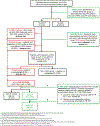Autism Spectrum Disorder: Incidence and Time Trends Over Two Decades in a Population-Based Birth Cohort
- PMID: 30519787
- PMCID: PMC6594832
- DOI: 10.1007/s10803-018-3834-0
Autism Spectrum Disorder: Incidence and Time Trends Over Two Decades in a Population-Based Birth Cohort
Abstract
We retrospectively identified autism spectrum disorder (ASD) incident cases among 31,220 individuals in a population-based birth cohort based on signs and symptoms uniformly abstracted from medical and educational records. Inclusive and narrow research definitions of ASD (ASD-RI and ASD-RN, respectively) were explored, along with clinical diagnoses of ASD (ASD-C) obtained from the records. The incidence of ASD-RI, ASD-RN, and ASD-C increased significantly from 1985 to 1998, then ASD-RI and ASD-RN plateaued while the rate of ASD-C continued to increase during 1998-2004. The rising incidence of research-defined ASD may reflect improved recognition and documentation of ASD signs and symptoms. Although the frequency of threshold ASD symptoms stabilized, the rate of ASD-C continued to increase, narrowing the gap between clinical ascertainment and symptom documentation.
Keywords: Autism spectrum disorder; Epidemiology; Incidence; Time trends.
Conflict of interest statement
Figures




Similar articles
-
Time Trends in Diagnostics and Clinical Features of Young Children Referred on Suspicion of Autism: A Population-Based Clinical Cohort Study, 2000-2010.J Autism Dev Disord. 2021 Feb;51(2):444-458. doi: 10.1007/s10803-020-04555-8. J Autism Dev Disord. 2021. PMID: 32474837
-
Prevalence of Autism Spectrum Disorder Among Children Aged 8 Years - Autism and Developmental Disabilities Monitoring Network, 11 Sites, United States, 2014.MMWR Surveill Summ. 2018 Apr 27;67(6):1-23. doi: 10.15585/mmwr.ss6706a1. MMWR Surveill Summ. 2018. PMID: 29701730 Free PMC article.
-
Incidence time trends and socioeconomic factors in the observed incidence of autism spectrum disorder in israel: A nationwide nested case-control study.Autism Res. 2019 Dec;12(12):1870-1879. doi: 10.1002/aur.2185. Epub 2019 Jul 31. Autism Res. 2019. PMID: 31365189 Free PMC article.
-
Clinical characteristics of children and young adults with co-occurring autism spectrum disorder and epilepsy.Epilepsy Behav. 2015 Jun;47:183-90. doi: 10.1016/j.yebeh.2014.12.022. Epub 2015 Jan 15. Epilepsy Behav. 2015. PMID: 25599987 Review.
-
[Scoping review of progress in cohort studies of autism spectrum disorder].Zhonghua Liu Xing Bing Xue Za Zhi. 2023 May 10;44(5):837-844. doi: 10.3760/cma.j.cn112338-20221027-00918. Zhonghua Liu Xing Bing Xue Za Zhi. 2023. PMID: 37221076 Chinese.
Cited by
-
Gestational Age, Perinatal Characteristics, and Autism Spectrum Disorder: A Birth Cohort Study.J Pediatr. 2020 May;220:175-183.e8. doi: 10.1016/j.jpeds.2020.01.022. Epub 2020 Feb 21. J Pediatr. 2020. PMID: 32093932 Free PMC article.
-
Frequentist Grouped Weighted Quantile Sum Regression for Correlated Chemical Mixtures.Stat Med. 2025 Mar 30;44(7):e70078. doi: 10.1002/sim.70078. Stat Med. 2025. PMID: 40213957 Free PMC article.
-
A genome-first study of sex chromosome aneuploidies provides evidence of Y chromosome dosage effects on autism risk.Nat Commun. 2024 Oct 15;15(1):8897. doi: 10.1038/s41467-024-53211-7. Nat Commun. 2024. PMID: 39406744 Free PMC article.
-
Prevalence of Autism Spectrum Disorder in 7-9-Year-Old Children in Denmark, Finland, France and Iceland: A Population-Based Registries Approach Within the ASDEU Project.J Autism Dev Disord. 2020 Mar;50(3):949-959. doi: 10.1007/s10803-019-04328-y. J Autism Dev Disord. 2020. PMID: 31813107
-
Multigenerational association between smoking and autism spectrum disorder: findings from a nationwide prospective cohort study.Am J Epidemiol. 2024 Aug 5;193(8):1115-1126. doi: 10.1093/aje/kwae038. Am J Epidemiol. 2024. PMID: 38583942 Free PMC article.
References
-
- American Psychiatric Association (2000). Diagnostic and Statistical Manual of Mental Disorders, 4th Edition, Text Revision (DSM-IV-TR). Washington, DC: American Psychiatric Publishing.
-
- American Psychiatric Association (2013). Diagnostic and Statistical Manual of Mental Disorders, Fifth Edition. VA: American Psychiatric Association.
-
- Atladottir HO, Gyllenberg D, Langridge A, Sandin S, Hansen SN, Leonard H, et al. (2015). The increasing prevalence of reported diagnoses of childhood psychiatric disorders: a descriptive multinational comparison. European Child and Adolescent Psychiatry, 24(2), 173–183. https://doi:10.1007/s00787-014-0553-8. - DOI - PubMed
-
- Baio J, Wiggins L, Christensen DL, Maenner MJ, Daniels J, Warren Z, et al. (2018). Prevalence of Autism Spectrum Disorder among Children Aged 8 Years - Autism and Developmental Disabilities Monitoring Network, 11 Sites, United States, 2014. MMWR Surveillence Summaries, 67(6), 1–23. https://doi:10.15585/mmwr.ss6706a1. - DOI - PMC - PubMed
-
- Baker JP (2013). Autism at 70--redrawing the boundaries. New England Journal of Medicine, 369(12), 1089–1091. https://doi:10.1056/NEJMp1306380. - DOI - PubMed
MeSH terms
Grants and funding
LinkOut - more resources
Full Text Sources
Medical
Miscellaneous

